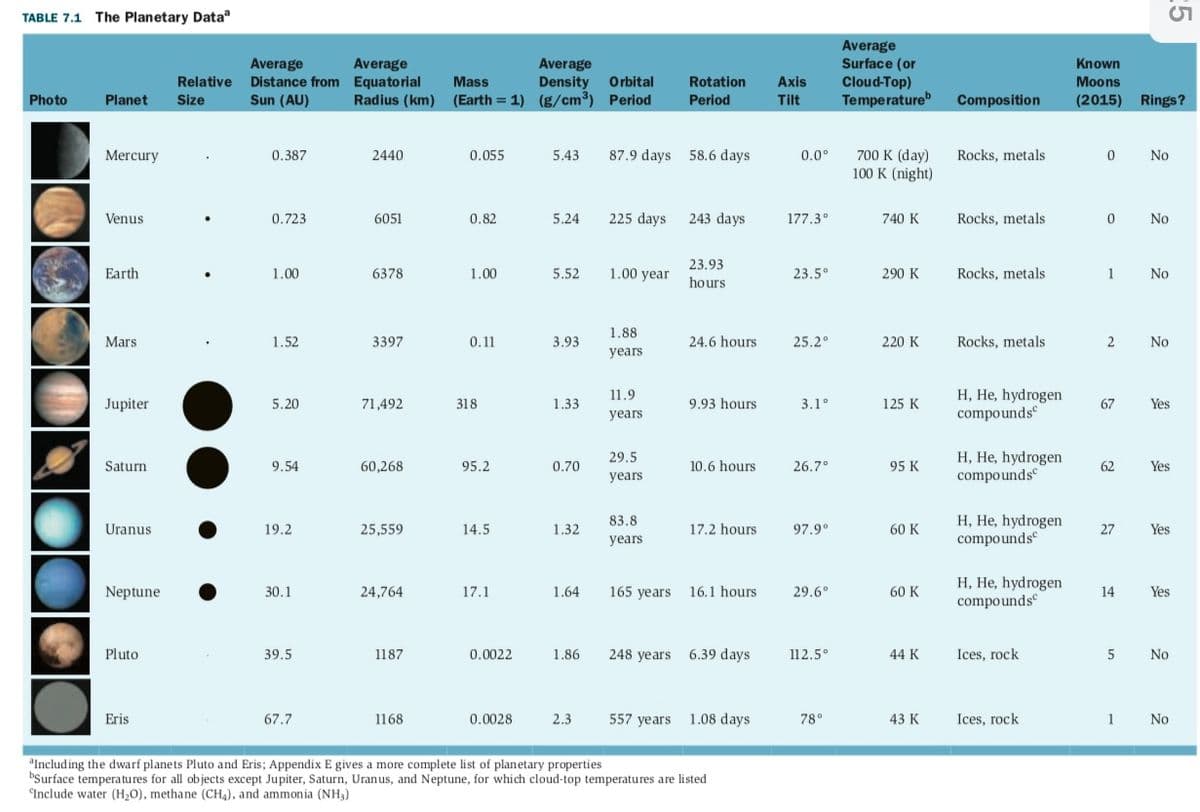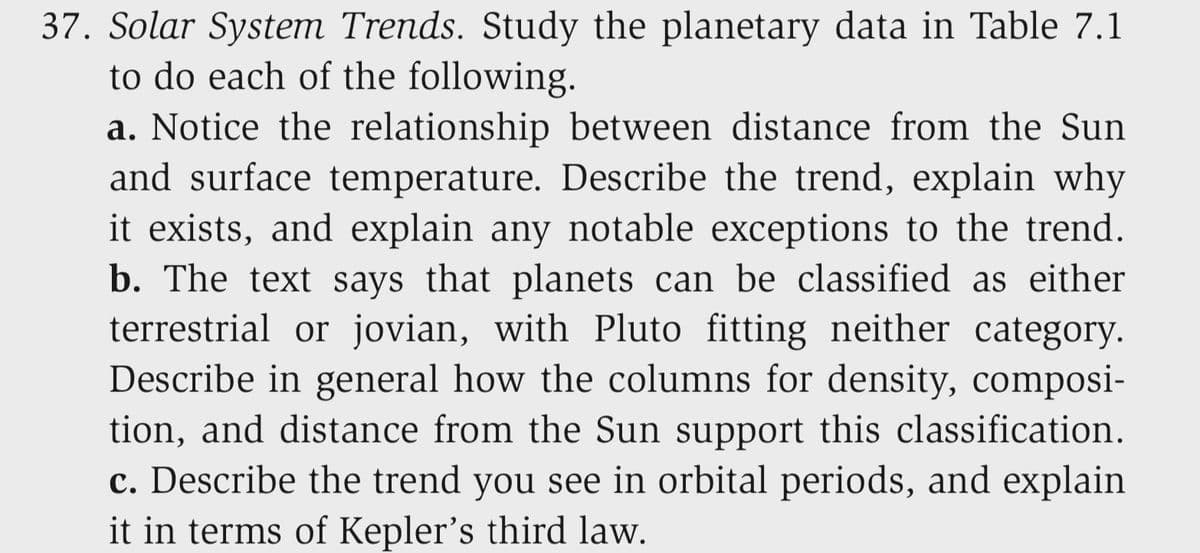Average Density Orbital (Earth = 1) (g/cm³) Period Average Surface (or Cloud-Top) Temperature Known Average Distance from Equatorial Sun (AU) Average Relative Mass Rotation Axis Мoons Photo Planet Size Radius (km) Period Tilt Composition (2015) Rings? 0,387 87.9 days 58.6 days 700 K (day) 100 K (night) Mercury 2440 0.055 5.43 0.0° Rocks, metals No Venus 0.723 6051 0.82 5.24 225 days 243 days 177.3 740 K Rocks, metals No 23.93 hours Earth 1.00 6378 1.00 5.52 1.00 year 23.5° 290 K Rocks, metals 1 No 1,88 Mars 1.52 3397 0.1 3.93 24.6 hours 25.2 220 K Rocks, metals No уears H, He, hydrogen compounds 11.9 Jupiter 5.20 71,492 318 1.33 9.93 hours 3.1° 125 K 67 Yes уears 29.5 H, He, hydrogen 0. 70
Average Density Orbital (Earth = 1) (g/cm³) Period Average Surface (or Cloud-Top) Temperature Known Average Distance from Equatorial Sun (AU) Average Relative Mass Rotation Axis Мoons Photo Planet Size Radius (km) Period Tilt Composition (2015) Rings? 0,387 87.9 days 58.6 days 700 K (day) 100 K (night) Mercury 2440 0.055 5.43 0.0° Rocks, metals No Venus 0.723 6051 0.82 5.24 225 days 243 days 177.3 740 K Rocks, metals No 23.93 hours Earth 1.00 6378 1.00 5.52 1.00 year 23.5° 290 K Rocks, metals 1 No 1,88 Mars 1.52 3397 0.1 3.93 24.6 hours 25.2 220 K Rocks, metals No уears H, He, hydrogen compounds 11.9 Jupiter 5.20 71,492 318 1.33 9.93 hours 3.1° 125 K 67 Yes уears 29.5 H, He, hydrogen 0. 70
Applications and Investigations in Earth Science (9th Edition)
9th Edition
ISBN:9780134746241
Author:Edward J. Tarbuck, Frederick K. Lutgens, Dennis G. Tasa
Publisher:Edward J. Tarbuck, Frederick K. Lutgens, Dennis G. Tasa
Chapter1: The Study Of Minerals
Section: Chapter Questions
Problem 1LR
Related questions
Question

Transcribed Image Text:TABLE 7.1 The Planetary Data
Average
Surface (or
Cloud-Top)
Temperature
Average
Average
Average
Distance from Equatorial
Radius (km)
Known
Relative
Mass
Density
Orbital
Rotation
Axis
Moons
Photo
Planet
Size
Sun (AU)
(Earth = 1) (g/cm3) Period
Period
Tilt
Composition
(2015) Rings?
0.387
87.9 days 58.6 days
700 K (day)
100 K (night)
Mercury
2440
0.055
5.43
0.0°
Rocks, metals
No
Venus
0.723
6051
0.82
5.24
225 days
243 days
177.3°
740 K
Rocks, metals
No
23.93
Earth
1.00
6378
1.00
5.52
1.00 year
23.5°
290 K
Rocks, metals
1
No
hours
1,88
Mars
1.52
3397
0.11
3.93
24.6 hours
25.2°
220 K
Rocks, metals
No
years
H, He, hydrogen
compounds
11.9
Jupiter
5,20
71,492
318
1.33
9.93 hours
3.1°
125 K
67
Yes
years
H, He, hydrogen
compounds
29.5
Saturn
9.54
60,268
95.2
0.70
10.6 hours
26.7°
95 K
62
Yes
years
H, He, hydrogen
compounds
83.8
Uranus
19.2
25,559
14.5
1.32
17.2 hours
97.9°
60 K
27
Yes
years
H, He, hydrogen
compounds
Neptune
30.1
24,764
17.1
1.64
165 years
16.1 hours
29.6°
60 K
14
Yes
Pluto
39.5
1187
0.0022
1.86
248 years
6.39 days
112.5°
44 K
Ices, rock
No
Eris
67.7
1168
0.0028
2.3
557 years 1.08 days
78°
43 K
Ices, rock
1
No
"Including the dwarf planets Pluto and Eris; Appendix E gives a more complete list of planetary properties
bSurface temperatures for all objects except Jupiter, Saturn, Uranus, and Neptune, for which cloud-top temperatures are listed
"Include water (H20), methane (CH4), and ammonia (NH3)
-5

Transcribed Image Text:37. Solar System Trends. Study the planetary data in Table 7.1
to do each of the following.
a. Notice the relationship between distance from the Sun
and surface temperature. Describe the trend, explain why
it exists, and explain any notable exceptions to the trend.
b. The text says that planets can be classified as either
terrestrial or jovian, with Pluto fitting neither category.
Describe in general how the columns for density, composi-
tion, and distance from the Sun support this classification.
c. Describe the trend you see in orbital periods, and explain
it in terms of Kepler's third law.
Expert Solution
This question has been solved!
Explore an expertly crafted, step-by-step solution for a thorough understanding of key concepts.
Step by step
Solved in 2 steps

Recommended textbooks for you

Applications and Investigations in Earth Science …
Earth Science
ISBN:
9780134746241
Author:
Edward J. Tarbuck, Frederick K. Lutgens, Dennis G. Tasa
Publisher:
PEARSON

Exercises for Weather & Climate (9th Edition)
Earth Science
ISBN:
9780134041360
Author:
Greg Carbone
Publisher:
PEARSON

Environmental Science
Earth Science
ISBN:
9781260153125
Author:
William P Cunningham Prof., Mary Ann Cunningham Professor
Publisher:
McGraw-Hill Education

Applications and Investigations in Earth Science …
Earth Science
ISBN:
9780134746241
Author:
Edward J. Tarbuck, Frederick K. Lutgens, Dennis G. Tasa
Publisher:
PEARSON

Exercises for Weather & Climate (9th Edition)
Earth Science
ISBN:
9780134041360
Author:
Greg Carbone
Publisher:
PEARSON

Environmental Science
Earth Science
ISBN:
9781260153125
Author:
William P Cunningham Prof., Mary Ann Cunningham Professor
Publisher:
McGraw-Hill Education

Earth Science (15th Edition)
Earth Science
ISBN:
9780134543536
Author:
Edward J. Tarbuck, Frederick K. Lutgens, Dennis G. Tasa
Publisher:
PEARSON

Environmental Science (MindTap Course List)
Earth Science
ISBN:
9781337569613
Author:
G. Tyler Miller, Scott Spoolman
Publisher:
Cengage Learning

Physical Geology
Earth Science
ISBN:
9781259916823
Author:
Plummer, Charles C., CARLSON, Diane H., Hammersley, Lisa
Publisher:
Mcgraw-hill Education,